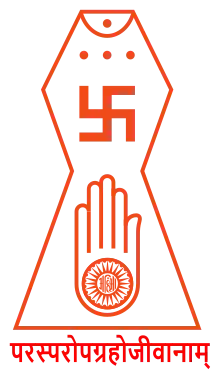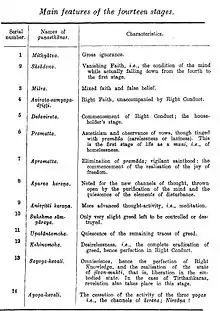Gunasthana
Guṇasthāna (Sanskrit: "levels of virtue") are the fourteen stages of spiritual development and growth through which a soul gradually passes before it attains moksha (liberation).[1] According to Jainism, it is a state of soul from a complete dependence on karma to the state of complete dissociation from it. Here the word virtue does not mean an ordinary moral quality, but it stands for the nature of soul — knowledge, belief and conduct.

Classification
| Part of a series on |
| Jainism |
|---|
 |
The fourteen Gunasthāna represents the soul's gradual manifestation of the innate qualities of knowledge, belief and conduct in a more and more perfect form.[2][3] Following are the stages of spiritual development:[4][5][6] The first four are concerned with Right Belief (Rationality in perception)
- 1. Mithyātva (Delusion)
- 2. Sasādana
- 3. Misradrsti (Mixed belief)
- 4. Avirata samyagdrsti (Vowless right belief)
The next one is about Minor Vows i.e. Commencement of Right conduct
- 5. Deśavirata (The stage of partial self-control)
The rest are about Right conduct: Mahavratas (Major Vows)
- 6.Pramattasamyata (Slightly imperfect vows)
- 7. Apramatta samyata (Perfect vows)
- 8. Apūrvakaraņa (New thought-activity)
- 9. Anivāttibādara-sāmparāya (Advanced thought-activity)
- 10.Sukshma samparaya (Slightest delusion)
- 11.Upaśānta-kasāya (Subsided delusion)
- 12.Ksīna kasāya (Destroyed delusion)
- 13.Sayoga kevali (Kevala Jnana with vibration)
- 14.Ayoga kevali (Moksha)
The Fourteen stages

| Head | Gunasthāna | Meaning |
|---|---|---|
| Belief (Rationality in perception) |
1. Mithyātva | The stage of wrong believer (Gross ignorance). If at this stage, a person meditates on his existence, there is a temporary suspension of the following:[7]
|
| 2. Sasādana | This gunasthāna represents the mental state of the soul in the process or act of falling from right faith. Here sā means "with" and sādana means "exhausted", hence that which is characterised by exhausted faith.[8] | |
| 3. Misradrsti | Misra literally means mixed. At this stage, a person hovers between certainty and doubt on Right belief.[8] | |
| 4. Avirata samyagdrsti | Vowless Right Belief - When doubts of an individual are removed, he/she reaches this stage and becomes a samyagdrishti (true believer)[9] | |
| Commencement of Right conduct (Śrāvaka) |
5. Deśavirata | Deśa means partial and virata means vow i.e. observance of the partial vows in pursuit of Right conduct.[9] |
| Right conduct (Major Vows) |
6. Pramattasamyata | First step of life as a Jain muni (monk).[9]| The stage of complete self-discipline, although sometimes brought into wavering through negligence. |
| 7. Apramatta samyata | Perfect vows | |
| 8. Apūrvakaraņa | New thought-activity. The stage of one in whom the passions are still occurring in a gross form. | |
| 9. Anivāttibādara-sāmparāya |
The stage of one who practices the process called annivrtti karaņa and in whom however the passions are still occurring | |
| 10.Sukshma sāmprāya | Slightest delusion.
The stage of one in whom the passions occur in a subtle form. | |
| 11.Upaśānta-kasāya | Subsided delusion. The stage of one who has suppressed every passion but still does not possess omniscience. | |
| 12.Ksīna kasāya | Destroyed delusion.
The stage of who has annihilated every passion but does not yet possess omniscience. | |
| 13.Sayoga kevali' | Omniscience with vibration.
Sa means "with" and yoga refers to the three channels of activity, i.e., mind, speech and body.[10] Kevali is a term used to refer the omniscient beings (arihantas). This stage is characterised by the destruction of all inimical (ghātiā) karmas and attainment of omniscience.[11] | |
| 14.Ayoga kevali | The stage of omniscience without any activity. This is the last stage on the Path, and is followed by the soul's destruction of the aghātiā karmas. Those who pass this stage are called siddha and become fully established in Right Faith, Right Knowledge and Right Conduct.[11] |
About the 12th stage it is mentioned in Jain text, Gommatsāra Jīvakanda:
That possessionless saint (Nirgrantha), all of whose deluding, passions (Moha Kashaya) are destroyed, and whose thought is clear like the water kept in a pure vessel of crystal Jewel is said by the non-attached (Conquerors) (to be in the 12th stage of) destroyed-delusion, or delusionless (Kshina Kashaya).
— Gommatsāra (62)[12]
The destruction of causes of bondage
The whole scheme of gunasthana in Jain philosophy is devised in a logical order according to the principle of decreasing sinfulness and increasing purity. At the first stage, all the five causes of bondage — Irrational beliefs (mithyatva), non-restraint (avirati), carelessness (pramada), passions (kashaya) and activities of mind, speech and body (yoga) — are in full operation.[13] Irrational beliefs (mithyatva) are partially suppressed in the second and third stages, and are eliminated in the fourth stage. In stages five and six, non-restraint (avirati) is gradually eliminated in stages. From the seventh stage onwards, carelessness is removed and only passions and activity exercise their influence. From the eleventh to the thirteenth all the passions are eliminated and only activity is present. On the last stage, there is no activity, hence no binding of karma.[13]
The destruction of karmas
Out of the four ghatiya karmas, darsana mohiniya karma (perception deluding karma) is destroyed first in the fourth stage of gunasthana. Caritra mohiniya karma (conduct deluding karma) is destroyed next in the twelfth gunasthana. The remaining three ghatiya karmas (knowledge obstructing karma, perception obstructing karma and energy obstructing karma) are destroyed in the 13th stage and the rest four aghatiya karmas (life-span determining, body determining, status determining and feeling producing karmas) are destroyed in the 14th or the last stage of gunasthana.[14]
See also
References
Citations
- Jaini, Padmanabh (1998) p. 141
- Jaini 1991, p. 95.
- Kuhn, Hermann (2001) p. 186–219
- Jain, Vijay K (26 March 2014). Acarya Pujyapada's Istopadesa – the Golden Discourse. Vikalp Printers. p. 14. ISBN 9788190363969.
- Jaini, Padmanabh (1998) p. 272–273
- Tatia, Nathmal (1994) p. 274–85
- Champat Rai Jain 1917, p. 41, 118.
- Champat Rai Jain 1917, p. 118.
- Champat Rai Jain 1917, p. 119.
- Champat Rai Jain 1917, p. 120.
- Champat Rai Jain 1917, p. 121.
- Jaini 1927, p. 46.
- Kuhn, Hermann (2001) p. 87–88
- Jaini, Padmanabh (1998) p. 133
Sources
- Jaini, Jagmandar-lāl (1927). Gommatsara Jiva-kanda. Alt URL
- Kuhn, Hermann (2001), Karma, The Mechanism : Create Your Own Fate, Wunstorf, Germany: Crosswind Publishing, ISBN 3-9806211-4-6
- Jaini, Padmanabh S. (1998), The Jaina Path of Purification, New Delhi: Motilal Banarsidass, ISBN 81-208-1578-5
- Jaini, Padmanabh S. (1991), Gender and Salvation: Jaina Debates on the Spiritual Liberation of Women, University of California Press, ISBN 0-520-06820-3
- Tatia, Nathmal (tr.) (1994), Tattvārtha Sūtra: That which Is of Vācaka Umāsvāti (in Sanskrit and English), Lanham, MD: Rowman Altamira, ISBN 0-7619-8993-5
- Champat Rai Jain (1917), The Practical Path, The Central Jaina Publishing House